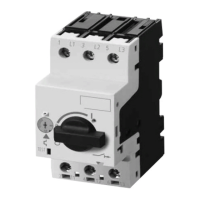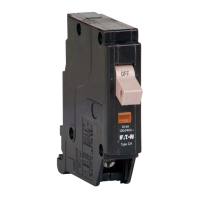I.B. 32-255-1G
Page 27
Effective 12/02
a. Breaker element open, closing springs discharged
b. Breaker element open, closing springs charged
c. Breaker element closed, closing springs discharged
d. Breaker element closed, closing springs charged
5-3.2 CHARGING
Figure 5-4 is a schematic view of the spring charging
parts of the stored energy mechanism.
The major component of the mechanism is a cam shaft
assembly which consists of a drive shaft to which are
attached two closing spring cranks (one on each end),
the closing cam, drive plates, and a free-wheeling ratch-
et wheel. The ratchet wheel is actuated by an oscillating
mechanism driven by the motor eccentric. As the ratchet
wheel rotates, it pushes the drive plates which in turn
rotate the closing spring cranks and the closing cam
with it.
The closing spring cranks have spring ends connected
to them, which are in turn coupled to the closing springs.
As the cranks rotate, the closing springs are charged.
When the closing springs are completely charged, the
spring cranks go over dead center, and the closing stop
roller comes against the spring release latch. The clos-
ing springs are now held in the fully charged position.
Closing springs may also be charged manually. Insert the
maintenance tool in the manual charging socket. Move it
up and down approximately 38 times until a clicking
sound is heard, and the closing springs charging indicator
indicates “Charged.” Any further motion of the mainte-
nance tool will result in free wheeling of the ratchet wheel.
5-3.3 CLOSING OPERATION
Figure 5-3 shows the position of the closing cam and
tripping linkage. Note that in Figure 5-3a in which the
circuit breaker is open and the closing springs are dis-
charged, the trip “D” shaft and trip latch are in the
unlatched position.
Once charged, the closing springs can be released to
close the circuit breaker by moving the spring release
latch out of the way. This is done electrically or manually
by depressing the spring release lever, which turns the
spring release latch out of the way of the closing stop
roller. The force of the closing spring rotates the cam
shaft through the spring cranks. The closing cam, being
attached to the cam shaft, in turn rotates the pole shaft
through the main link to close the circuit breaker.
In Figure 5-3c the linkage is shown with the circuit
breaker in the closed position before the closing springs
have been recharged. Interference of the trip “D” shaft
with the trip latch prevents the linkage from collapsing,
and the circuit breaker is held closed.
Figure 5-3d shows the circuit breaker in the closed posi-
tion after the closing springs have been recharged. Note
that the spring charging rotates the closing cam by one
half turn. Since the cam surface in contact with the main
link roller is cylindrical in this region, the spring charging
operation does not affect the mechanism linkage.
Since the primary contacts are completely enclosed in
the vacuum interrupter and not adjustable in any way, a
“Slow Close” capability is not provided with VCP-W cir-
cuit breakers.
5-3.4 TRIPPING OPERATION
When the trip “D” shaft is turned either by the trip button
or trip coil, all links return to the original “open” condition
shown in Figure 5-3a.
5-3.5 TRIP FREE OPERATION
When the manual trip button is held depressed, any
attempt to close the circuit breaker results in the dis-
charge of the closing springs without any movement of
the pole shaft or vacuum interrupter stem.
5-4 CONTROL SCHEMES
There are two basic control schemes for VCP-W circuit
breakers, one for DC control and one for AC control
voltages (Figure 5-5). There may be different control
voltages or more than one tripping element, but the prin-
cipal mode of operation is as follows:
As soon as the control voltage is applied, the spring
charging motor automatically starts charging the closing
springs. When the springs are charged, the motor cut off
LS1/bb switch turns the motor off. The circuit breaker
may be closed by making the control switch close
(CS/C) contact. Automatically upon closing of the circuit
breaker, the motor starts charging the closing springs.
The circuit breaker may be tripped at any time by mak-
ing the control switch trip (CS/T) contact.
Note the position switch (PS1) contact in the spring
release circuit in the scheme. The contact remains
made while the circuit breaker is being levered between
the TEST and CONNECTED positions. Consequently, it
prevents the circuit breaker from closing automatically,
even though the control close contact (CS/C) may have

